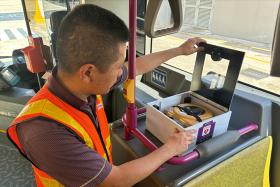How a damaged cable turned into a major MRT disruption
Power cable insulation fault sparked events that led to 'avoidable' incident affecting thousands of commuters
A damaged power cable led to a series of events that caused a major MRT disruption affecting three train lines on Wednesday night - an incident that transport experts said could have been avoided.
Public transport operator SMRT Corporation - which runs the North-South, East-West and Circle lines that were hit - said in an update yesterday that the incident started with the breakdown of the insulation of a power cable.
The cable was between the Tuas Link and Tuas West Road stations on the East-West Line. A circuit breaker at Tuas West Road station that should have isolated the fault failed to do so.
This caused the North-South and East-West lines' power system to trip, bringing down stretches of the two oldest and most-used train lines at 7pm, during evening peak hour, and affecting thousands of commuters. The affected stations were between Woodlands and Jurong East on the North-South Line, and Queenstown and Gul Circle on the East-West Line.
The power fault caused blackouts at train stations and stranded commuters on stalled trains.
SMRT then tried to draw power from the Buona Vista intake substation, which also serves the Circle Line.
But this was done without first isolating the initial fault and resulted in the Circle Line being hit at 7.30pm, affecting more commuters as train services stopped along a 16-station stretch, from HarbourFront to Serangoon stations.
SMRT said it is working with the Land Transport Authority to conduct a full investigation into the "premature failure" of the components. The equipment manufacturers that supplied the parts are also being investigated.
WORST
Wednesday's disruption was the worst of its kind to hit the MRT network since 2017, when stretches of the North-South and East-West lines were also disrupted due to a power fault.
The concurrent failure of three train lines is also rare.
The Straits Times understands that the latest fault is unrelated to ongoing power replacement works on the North-South and East-West lines. It originated from a stretch of the East-West Line that is relatively new and not involved in the replacement works.
The disruption was likely a one-off incident due to the confluence of factors that increased the scale of the disruption, said Assistant Professor Raymond Ong of the National University of Singapore, who researches transport infrastructure.
But he said SMRT has to relook how it reacts to faults: "There needs to be protocols in place to prevent one system from affecting another. This is critical. Wednesday's incident was avoidable."
He added that a better evacuation plan in the event of inclement weather is also necessary, as the elderly and sick will suffer during the prolonged wait.
The evacuation of some trains took nearly three hours on Wednesday, with the wet weather and lightning risks impeding progress.
Singapore University of Social Sciences transport researcher Park Byung Joon said it was easy with the benefit of hindsight to blame SMRT for drawing power from the substation without first isolating the fault, but it must be noted a decision had to be made there and then with imperfect information.
"They were facing multiple failures and did not have the full picture," he said. "They should create a checklist so that they know what to do in case of multiple failures like this to prevent it from happening again."
Transport Minister Ong Ye Kung said the incident was a reminder to him and transport operators not to be complacent.
"(The MRT network) is a complex system, every little part matters, just as every worker, every engineer, every station manager also matters," he said.
"(We must) continue to work hard together to make sure the system works as well as possible."
FOR MORE, READ THE STRAITS TIMES
Get The New Paper on your phone with the free TNP app. Download from the Apple App Store or Google Play Store now


